The Contribution of Petroleum Charging Episodes to Different Strike-Slip Fault Zones in the Shunbei Area, the Tarim Basin, NW China
Abstract
1. Introduction
2. Geological Setting

3. Materials and Methods
4. Results
4.1. Petrology and Mineralogy
4.2. Fluid Inclusions
4.2.1. Fluid Inclusion Petrography
4.2.2. Fluorescence Spectroscopy
4.2.3. Microthermometry
5. Discussion
5.1. Hydrocarbon Charging History
5.1.1. Fluorescence Spectrum Analysis
5.1.2. Timing of Petroleum Charge
5.2. Paleoenvironment and Paleoclimate Changes
5.2.1. Principle and Methodology of Calculating Contributions

5.2.2. Calculation of the Contribution of Each Episode of Petroleum Charging
5.3. Factors Controlling the Difference in the Contribution of Each Oil Charging Episode
5.3.1. The Paleotectonic Fault Pattern
5.3.2. Strike-Slip Fault Activity Controlling Charging Episodes
5.4. Petroleum Accumulation Model
6. Conclusions
Supplementary Materials
Author Contributions
Funding
Data Availability Statement
Acknowledgments
Conflicts of Interest
References
- He, Z.L.; Ma, Y.S.; Zhu, D.Y.; Duan, T.Z.; Geng, J.H.; Zhang, J.T.; Ding, Q.; Qian, Y.X.; Wo, Y.J.; Gao, Z.Q. Theoretical and technological progress and research direction of deep and ultra-deep carbonate reservoirs. Oil Gas Geol. 2021, 42, 533–546, (In Chinese with English abstract). [Google Scholar]
- Dyman, T.S.; Crovelli, R.A.; Bartberger, C.E.; Takahashi, K.I. Worldwide estimates of deep natural gas resources based on the U.S. Geological Survey World Petroleum Assessment 2000. Nat. Resour. Res. 2002, 11, 207–218. [Google Scholar] [CrossRef]
- Bai, G.P.; Cao, B.F. Characteristics and distribution patterns of deep petroleum accumulations in the world. Oil Gas Geol. 2014, 35, 19–25, (In Chinese with English abstract). [Google Scholar]
- Heydari, E. The role of burial diagenesis in hydrocarbon destruction and H2S accumulation, upper Jurassic Smackover Formation, Black Creek Field, Mississippi. AAPG Bull. 1997, 81, 26–45. [Google Scholar]
- Ehrenberg, S.N.; Nadeau, P.H.; Steen, Ø. Petroleum reservoir porosity versus depth: Influence of geological age. AAPG Bull. 2009, 93, 1281–1296. [Google Scholar] [CrossRef]
- Jia, L.Q.; Cai, C.F.; Jiang, L.; Zhang, K.; Li, H.X.; Zhang, W. Petrological and geochemical constraints on diagenesis and deep burial dissolution of the Ordovician carbonate reservoirs in the Tazhong area, Tarim Basin, NW China. Mar. Pet. Geol. 2016, 78, 271–290. [Google Scholar] [CrossRef]
- Lv, H.T.; Han, J.; Zhang, J.B.; Liu, Y.L.; Li, Y.T. Development characteristics and formation mechanism of ultra-deepcarbonate fault-dissolution body in Shunbei area, Tarim Basin. Pet. Geol. Exp. 2021, 43, 15–22, (In Chinese with English abstract). [Google Scholar]
- Li, H.; Tang, H.M.; Qin, Q.R.; Zhou, J.L.; Qin, Z.J.; Fan, C.H.; Su, P.D.; Wang, Q.; Zhong, C. Characteristics, formation periods and genetic mechanisms of tectonic fractures in the tight gas sandstones reservoir: A case study of Xujiahe Formation in YB area, Sichuan Basin, China. J. Pet. Sci. Eng. 2019, 178, 723–735. [Google Scholar] [CrossRef]
- Li, J.; Li, H.; Yang, C.; Wu, Y.J.; Gao, Z.; Jiang, S.L. Geological characteristics and controlling factors of deep shale gas enrichment of the Wufeng-Longmaxi Formation in the southern Sichuan Basin, China. Lithosphere 2022, 12, 4737801. [Google Scholar] [CrossRef]
- Sun, L.D.; Zou, C.N.; Zhu, R.K.; Zhang, Y.H.; Zhang, S.C.; Zhang, B.M.; Zhu, G.Y.; Gao, Z.Y. Formation, distribution and potential of deep hydrocarbon resources in China. Pet. Explor. Dev. 2013, 40, 641–649, (In Chinese with English abstract). [Google Scholar] [CrossRef]
- Jia, C.Z.; Pang, X.Q. Research processes and main development directions of deep hydrocarbon geological theories. Acta Pet. Sin. 2015, 36, 1457–1469, (In Chinese with English abstract). [Google Scholar]
- Qi, L.X. Oil and gas breakthrough in ultra-deep Ordovician carbonate formations in Shuntuoguole uplift, Tarim Basin. China Pet. Explor. 2016, 21, 1672–7703, (In Chinese with English abstract). [Google Scholar]
- Gu, Y.; Wan, Y.L.; Huang, J.W.; Zhuang, X.B.; Wang, B.; Li, M. Prospects for ultra-deep oil and gas in the “deep burial and high pressure” Tarim Basin. Pet. Geol. Exp. 2019, 41, 157–164, (In Chinese with English abstract). [Google Scholar]
- Yun, L. Controlling effect of NE strike-slip fault system on reservoir development and hydrocarbon accumulation in the eastern Shunbei area and its geological significance, Tarim Basin. China Pet. Explor. 2021, 26, 41–52, (In Chinese with English abstract). [Google Scholar]
- Jiao, F.Z. Significance and prospect of ultra-deep carbonate fault-karst reservoirs in Shunbei area, Tarim Basin. Oil Gas Geol. 2018, 39, 207–216, (In Chinese with English abstract). [Google Scholar]
- Wang, B.; Zhao, Y.Q.; He, S.; Guo, X.W.; Cao, Z.C.; Deng, S.; Wu, X.; Yang, Y. Hydrocarbon accumulation stages and their controlling factors in the northern Ordovician Shunbei 5 fault zone, Tarim Basin. Oil Gas Geol. 2020, 41, 965–974, (In Chinese with English abstract). [Google Scholar]
- Lu, Z.Y.; Li, Y.T.; Ye, N.; Zhang, S.N.; Lu, C.J.; Li, W.; Cheng, Z.; Ding, X.Q.; Zhu, B.; Huang, B.W. Fluid Inclusions Record Hydrocarbon Charge History in the Shunbei Area, Tarim Basin, NW China. Geofluids 2020, 2020, 8847247. [Google Scholar] [CrossRef]
- Wang, Y.W.; Chen, H.H.; Guo, H.F.; Zhu, Z.H.; Wang, Q.R.; Yu, P.; Qi, L.X.; Yun, L. Hydrocarbon charging history of the ultra-deep reservoir in Shun 1 strike-slip fault zone, Tarim Basin. Oil Gas Geol. 2019, 40, 972–989, (In Chinese with English abstract). [Google Scholar]
- Han, Q.; Yun, L.; Jiang, H.S.; Shao, X.M.; Jin, X.M. Marine Oil and Gas Filling and Accumulation Process in the North of Shuntuoguole Area in Northern Tarim Basin. J. Jilin Univ. Earth Sci. Ed. 2021, 51, 645–658, (In Chinese with English abstract). [Google Scholar]
- Chen, Q.L.; Xi, B.B.; Han, J.; Xu, J.; Wu, X.; Zhu, X.X.; Ma, Z.L. Preservation and influence factors of ultra-deep oil reservoirs in Shuntuoguole area, Tarim Basin: Evidence from fluid inclusions. China Pet. Explor. 2020, 25, 121–133, (In Chinese with English abstract). [Google Scholar]
- He, Z.L.; Jin, X.H.; Wo, Y.J.; Li, H.L.; Bai, Z.R.; Jiao, C.L.; Zhang, Z.P. Hydrocarbon accumulation characteristics and exploration domains of ultra-deep marine carbonates in China. China Pet. Explor. 2016, 21, 3–14, (In Chinese with English abstract). [Google Scholar]
- Ni, Z.Y.; Wang, T.G.; Li, M.J.; Chen, Z.H.; Ou, G.X.; Cao, Z.C. Natural gas characteristics, fluid evolution, and gas charging time of the Ordovician reservoirs in the Shuntuoguole region, Tarim Basin, NW China. Geol. J. 2016, 53, 947–959. [Google Scholar] [CrossRef]
- He, D.F.; Zhou, X.Y.; Yang, H.J.; Guan, S.W.; Zhang, C.J. Formation mechanismand tectonic types of intracratonic paleo-uplifts in the Tarim basin. Earth Sci. Front. 2008, 15, 207–221, (In Chinese with English abstract). [Google Scholar]
- Deng, S.; Li, H.L.; Zhang, Z.P.; Wu, X.; Zhang, J.B. Characteristics of differential activities in major strike-slip fault zones andtheir control on hydrocarbon enrichment in Shunbei areaand its surroundings, Tarim Basin. Oil Gas Geol. 2018, 39, 878–888, (In Chinese with English abstract). [Google Scholar]
- Lv, H.T.; Zhang, S.N.; Ma, Q.Y. Classification and formation mechanismof fault systems in the central and northern Tarim Basin. Pet. Geol. Exp. 2017, 39, 444–452, (In Chinese with English abstract). [Google Scholar]
- Deng, S.; Li, H.L.; Han, J.; Cui, D.Y.; Zou, R. Characteristics of the central segment of Shunbei 5 strike-slip fault zone in Tarim Basin and its geological significance. Oil Gas Geol. 2019, 40, 990–998, (In Chinese with English abstract). [Google Scholar]
- Jiao, F.Z. Significance of oil and gas exploration in NE strike-slip fault belts in Shuntuoguole area of Tarim Basin. Oil Gas Geol. 2017, 38, 832–839, (In Chinese with English abstract). [Google Scholar]
- Bodnar, R.J. Revised equation and table for determining the freezing-point depression of H2O-NaCl solutions. Geochim. Cosmochim. Acta 1993, 57, 683–684. [Google Scholar] [CrossRef]
- Wang, Y.W. Multiple Originanl Mechanisms of the Ordovician Reservoir and Their Control on Hydrocarbon Charging in Shuntuoguole Area, Tarim Basin. Ph.D. Thesis, China University of Geosciences (Wuhan), Wuhan, China, 2019. [Google Scholar]
- Munz, I.A. Petroleum inclusions in sedimentary basins: Systematics, analytical methods and applications. Lithos 2001, 55, 195–212. [Google Scholar] [CrossRef]
- Yang, P.; Liu, K.Y.; Liu, J.L.; Yu, S.; Yu, B.; Hou, M.G.; Wu, L.Y. Petroleum charge history of deeply buried carbonate reservoirs in the Shuntuoguole Low Uplift, Tarim Basin, west China. Mar. Pet. Geol. 2021, 128, 105063. [Google Scholar] [CrossRef]
- McLimans, R.K.; Videtich, P.E. Diagenesis and burial history of great oolite limestone, Southern England. AAPG Am. Assoc. Pet. Geol. Bull. 1989, 73, 1195–1205. [Google Scholar]
- Guilhaumou, N.; Szydlowskii, N.; Pradier, B. Characterization of hydrocarbon fluid inclusions by infrared and fluorescence microspectrometry. Mineral. Mag. 1990, 54, 311–324. [Google Scholar] [CrossRef]
- Liu, X.; Chen, H.; Xiao, X.; Zhang, H.; Wang, Y.; Xu, T.; Shang, P.; Kong, L. Overpressure evolution recorded in fluid inclusions in the Dongpu Depression, Bohai Bay Basin, North China. J. Earth Sci. 2022, 33, 916–932. [Google Scholar] [CrossRef]
- McLimans, R.K. The application of fluid inclusions to migration of oil and diagenesis in petroleum reservoirs. Appl. Geochem. 1987, 2, 585–603. [Google Scholar] [CrossRef]
- Chen, H.H. Microspetrofluorimetric characterization and thermal maturity assessment of individual oil inclusion. Acta Pet. Sincia 2014, 35, 584–590, (In Chinese with English abstract). [Google Scholar]
- Blanchet, A.; Pagel, M.; Walgenwitz, F.; Lopez, A. Microspectrofluorimetric and microthermometric evidence for variability in hydrocarbon fluid inclusions in quartz overgrowths: Implications for inclusion trapping in the Alwyn North field, North Sea. Org. Geochem. 2003, 34, 1477–1490. [Google Scholar] [CrossRef]
- Ping, H.W.; Chen, H.H.; Jia, G.H. Petroleum accumulation in the deeply buried reservoirs in the northern Dongying Depression, Bohai Bay Basin, China: New insights from fluid inclusions, natural gas geochemistry, and 1-D basin modeling. Mar. Pet. Geol. 2017, 80, 70–93. [Google Scholar] [CrossRef]
- Karlsen, D.A.; Nedkvitne, T.; Larter, S.R.; Bjørlykke, K. Hydrocarbon composition of authigenic inclusions: Application to elucidation of petroleum reservoir filling history. Geochem. Cosmochim. Acta 1993, 57, 3641–3659. [Google Scholar] [CrossRef]
- Xiong, W.L.; Chen, H.H.; Yun, L.; Li, H.L.; Feng, Y.; Wu, Y.; Su, A. Hydrocarbon charging history for Silurian reservoirs of Shuntuoguole block in the north slope of Tazhong uplift, Tarim Basin: Constraints from fluid inclusion of Well Shun 9. Acta Pet. Sin. 2013, 34, 239–246, (In Chinese with English abstract). [Google Scholar]
- Bodnar, R. Petroleum migration in the Miocene Monterey Formation, California, USA: Constraints from fluid-inclusion studies. Mineral. Mag. 1990, 54, 295–304. [Google Scholar] [CrossRef]
- Hallmann, C.O.E.; Arouri, K.R.; McKirdy, D.M.; Schwark, L. Temporal resolution of an oil charging history e a case study of residual oil benzocarbazoles from the Gidgealpa Field. Org. Geochem. 2007, 38, 1516–1536. [Google Scholar] [CrossRef]
- Ping, H.W.; Chen, H.H.; Song, G.Q.; Liu, H.M. Contributions Degree of Petroleum Charging to Oil and Gas Accumulation and Its Significance. Earth Sci. J. China Univ. Geosci. 2012, 37, 163–170, (In Chinese with English abstract). [Google Scholar]
- Xie, D.Q.; Zheng, M.L.; Jiang, H.S.; Guo, X. Formation and Evolution of the Shaya Uplift and Constraints on Oil and Gas Distribution in the Tarim Basin. Geotecton. Metallog. 2013, 37, 398–409, (In Chinese with English abstract). [Google Scholar]
- Jin, Z.J.; Liu, Q.Y.; Yun, J.B. Potential Petroleum Sources and Exploration Directions around the Manjar Sag in the Tarim Basin. Sci. China Earth Sci. 2017, 60, 235–245. [Google Scholar] [CrossRef]
- Eichhubl, P.; Davatzes, N.C.; Becker, S.P. Structural and diagenetic control of fluid migration and cementation along the Moab fault, Utah. AAPG Bull. 2009, 93, 653–681. [Google Scholar] [CrossRef]
- Ilg, B.R.; Hemmings-Sykes, S.; Nicol, A.; Baur, J.; Fohrmann, M.; Funnell, R.; Milner, M. Normal faults and gas migration in an active plate boundary, southern Taranaki Basin, offshore New Zealand. AAPG Bull. 2012, 96, 1733–1756. [Google Scholar] [CrossRef]
- Yun, L. Hydrocarbon Accumulation of Ultra-Deep Ordovician Fault-Karst Reservoirs in Shunbei Area. Xinjiang Pet. Geol. 2021, 42, 136–142, (In Chinese with English abstract). [Google Scholar]
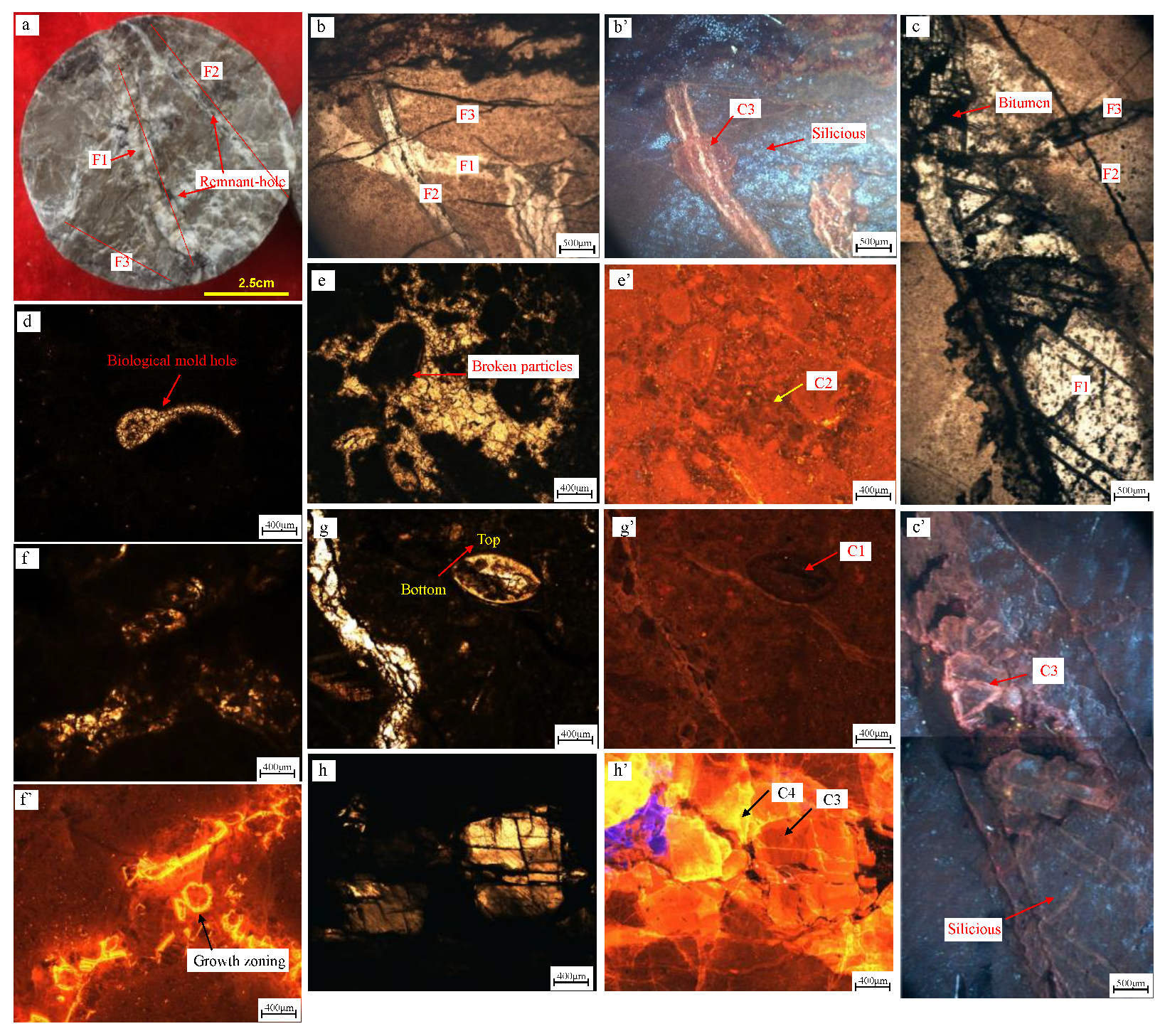
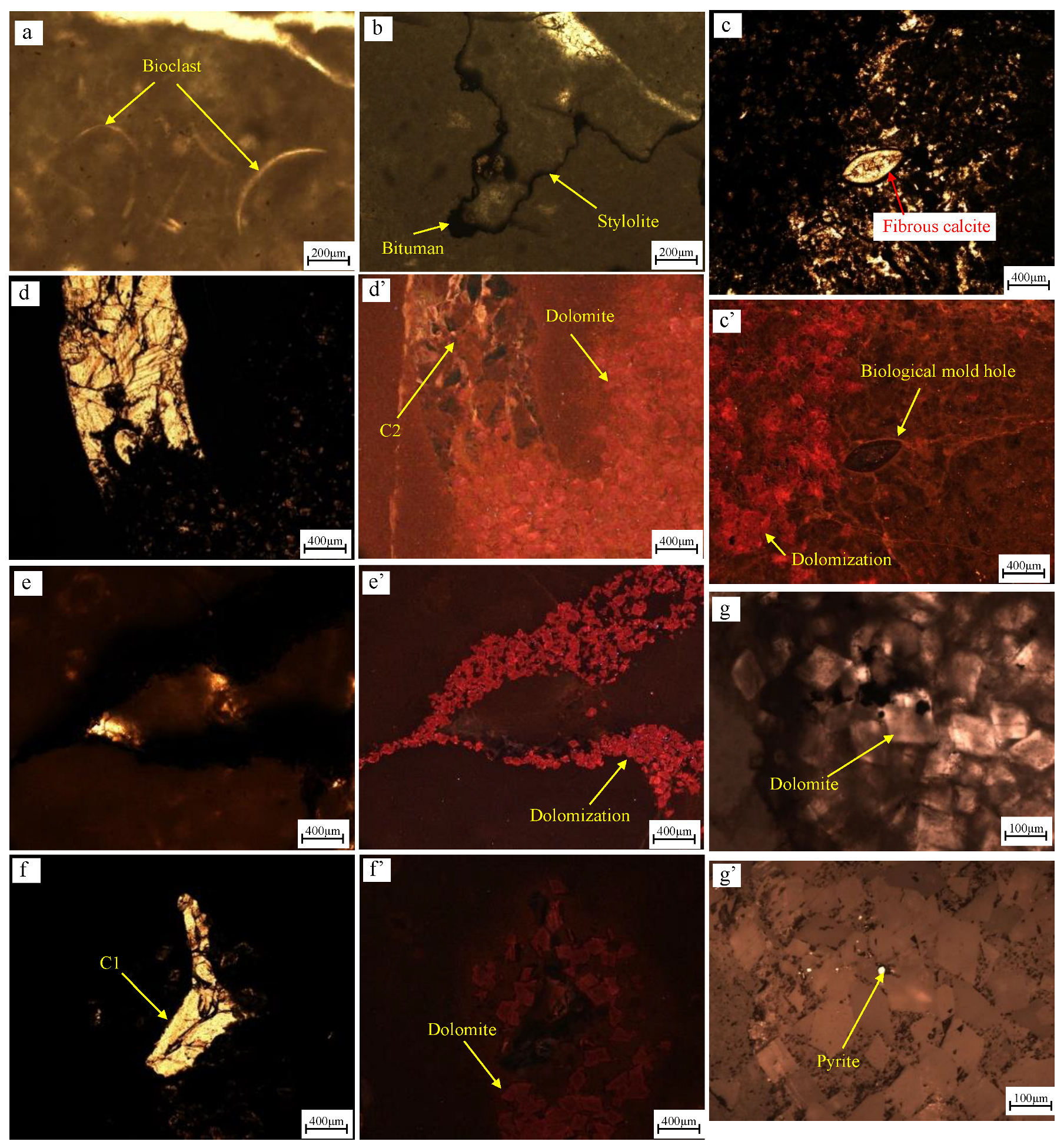
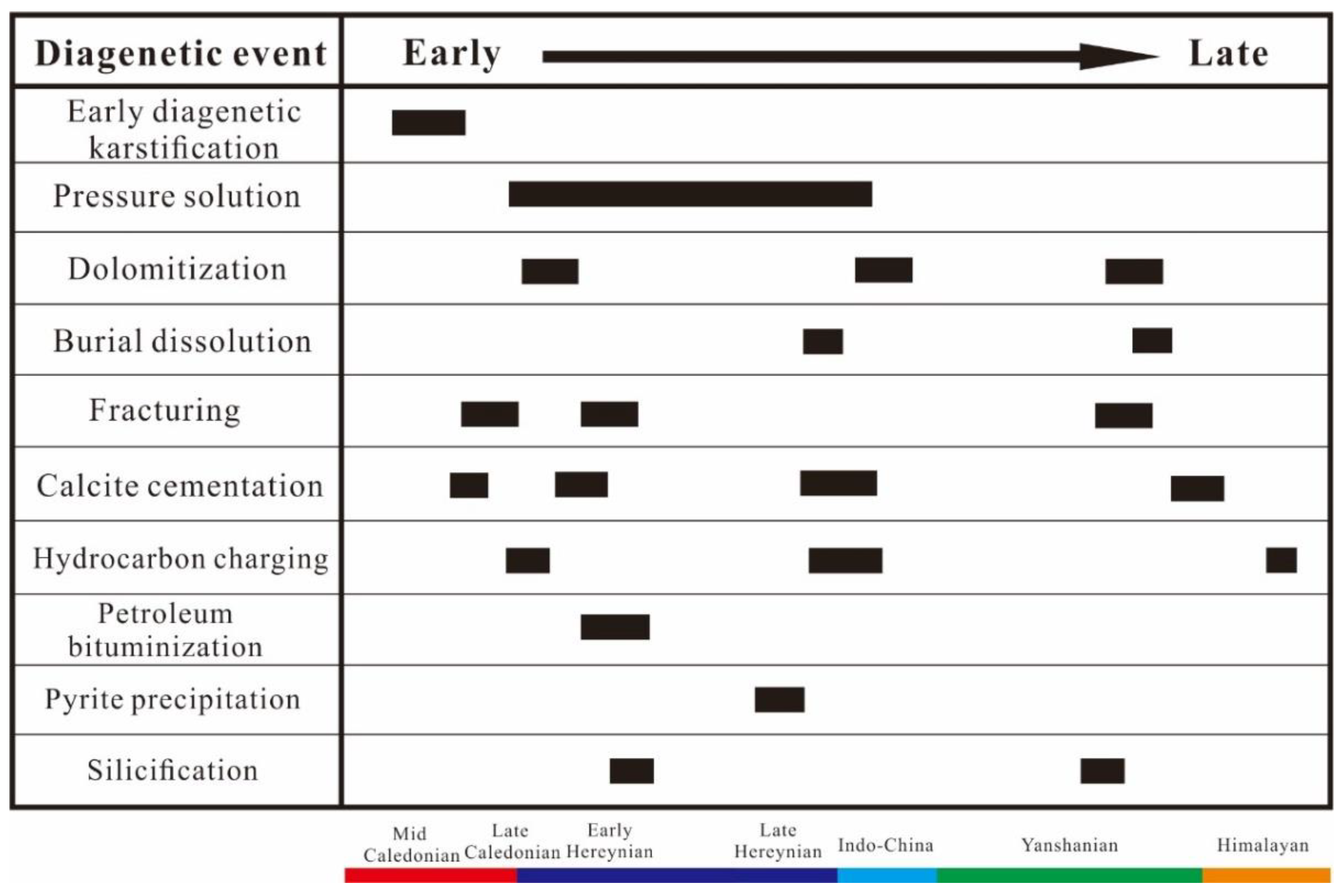
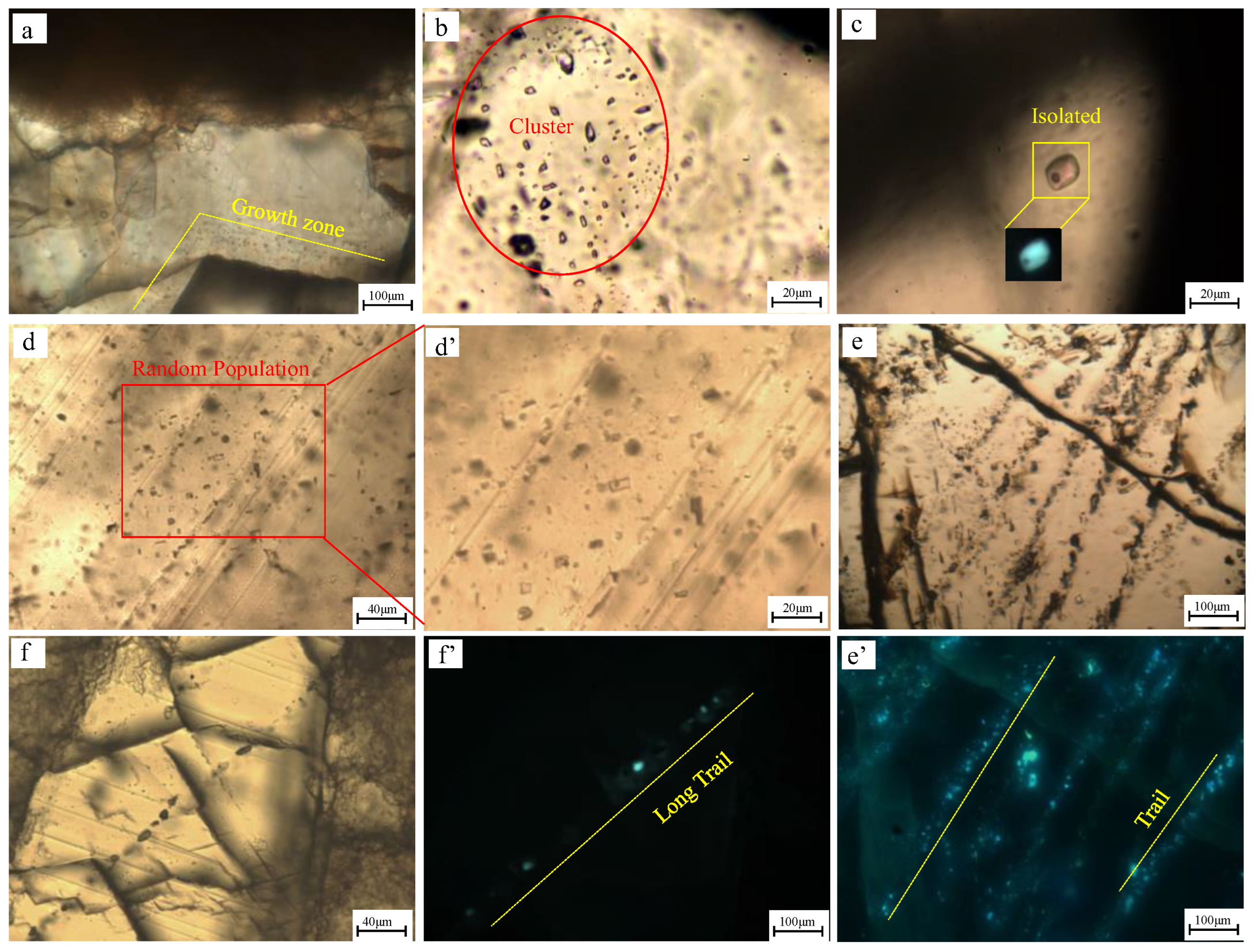
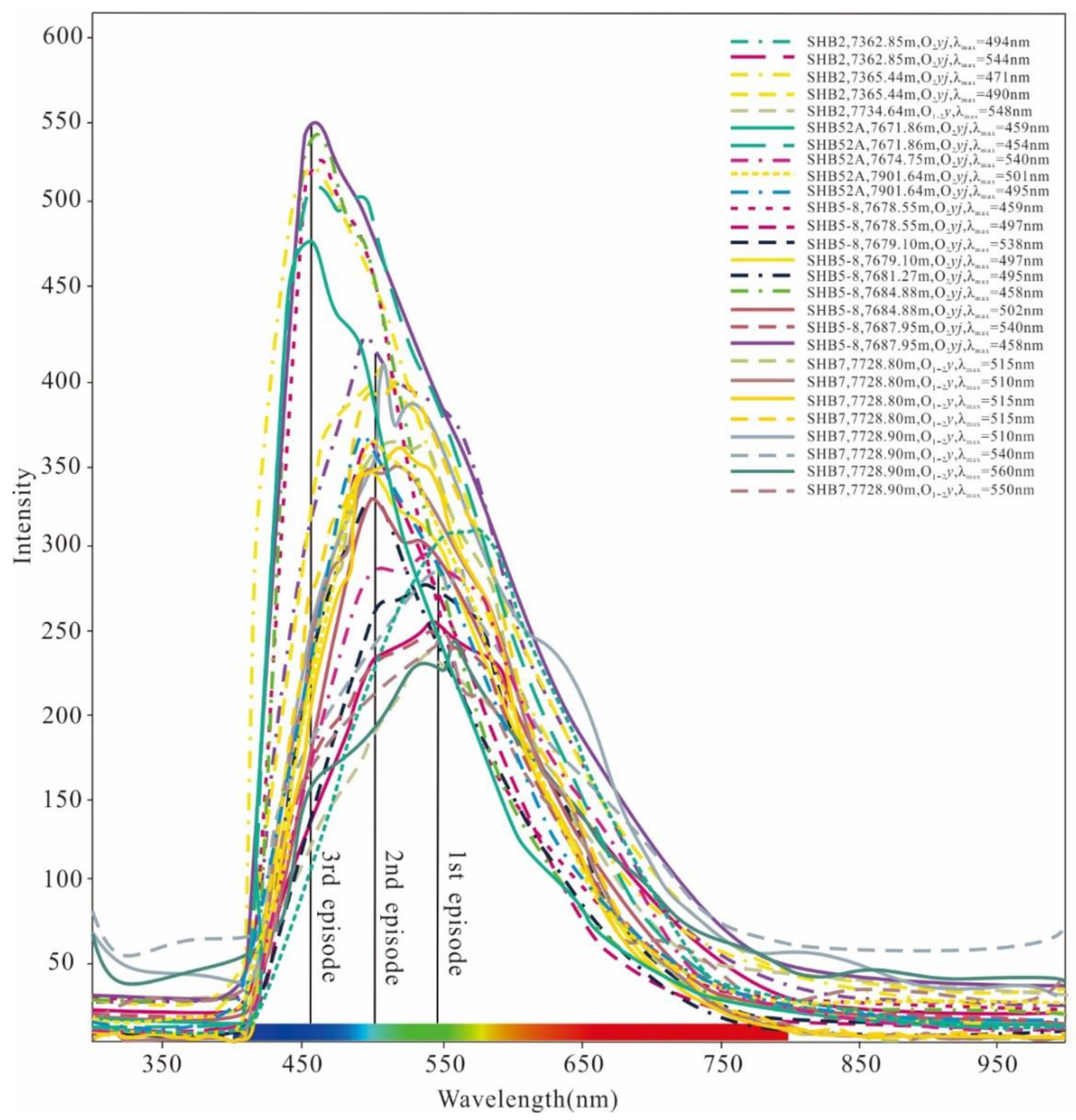
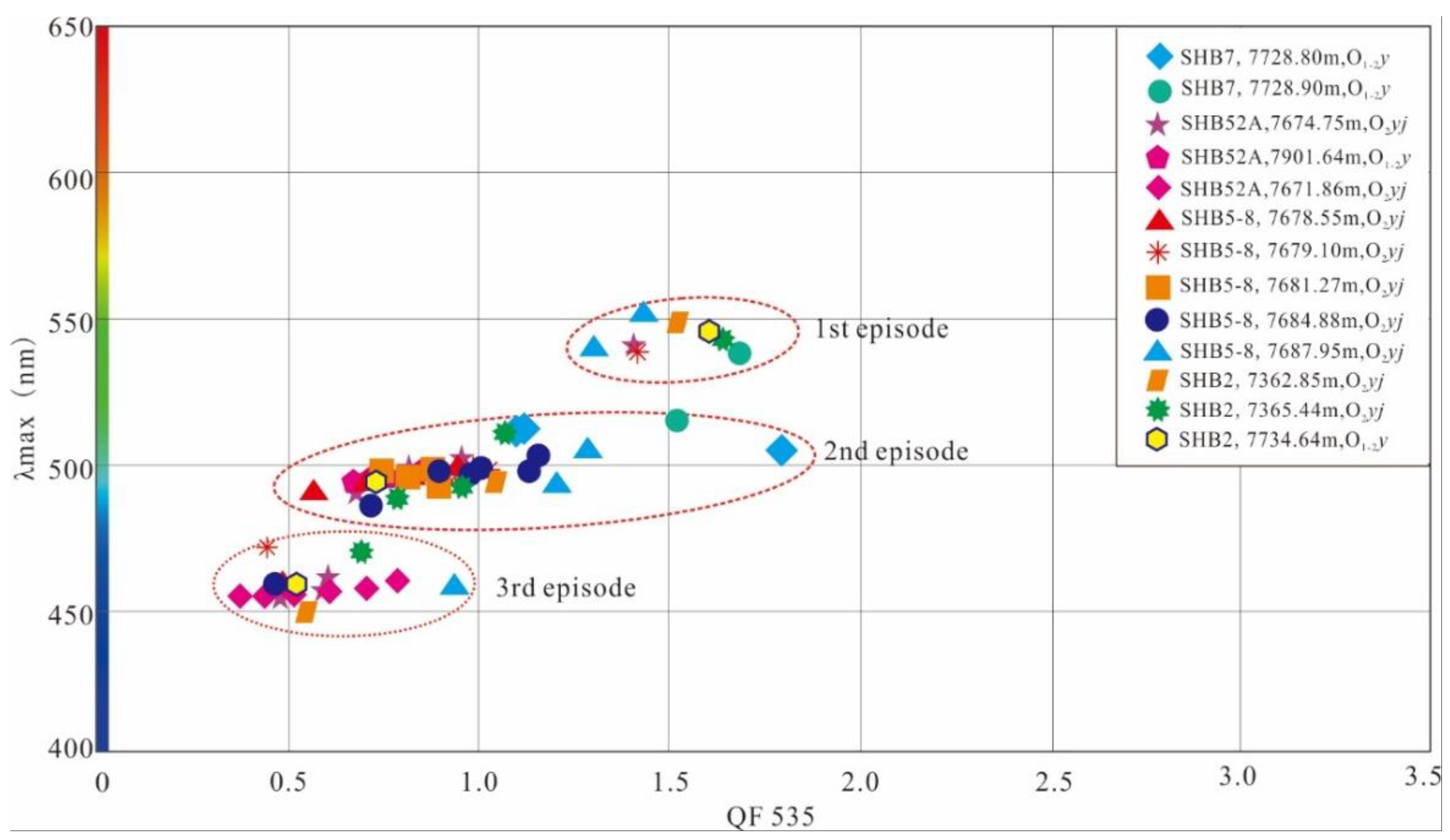

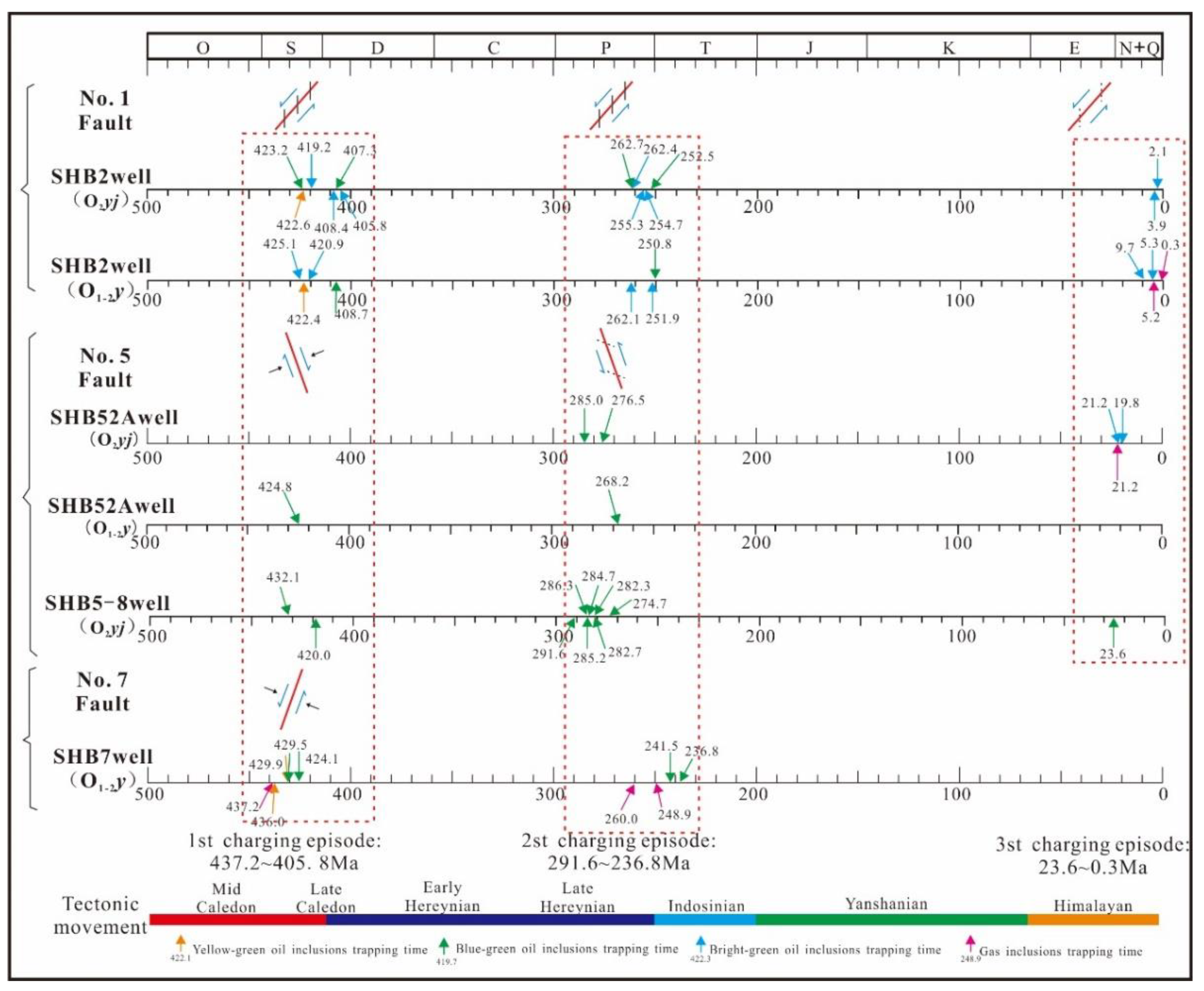

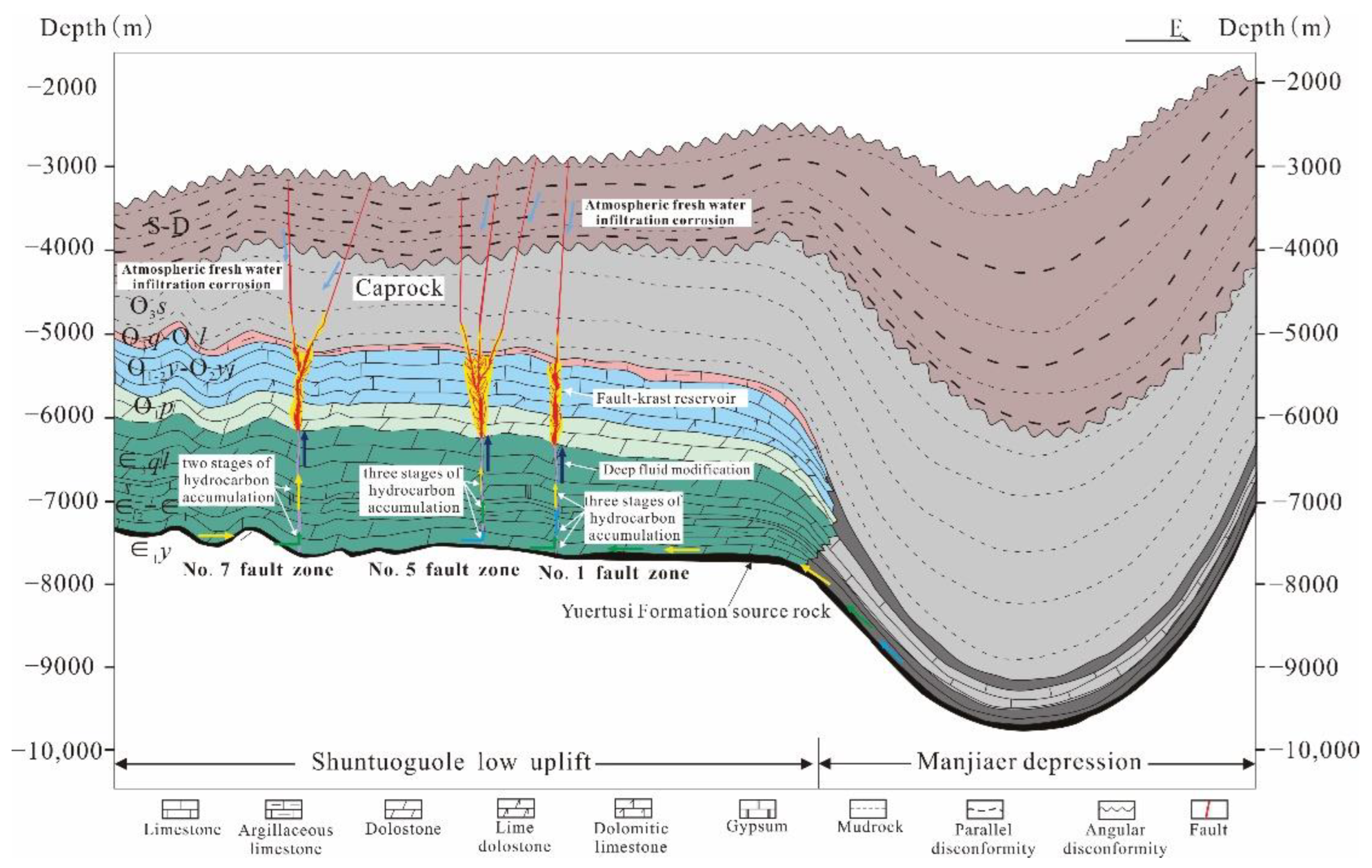
| Fault | Well | Formation | λmax (nm) | QF535 | Stage | Mean λmax (nm) | Mean QF535 | Density (D) ① (g/cm3) | API° ② |
|---|---|---|---|---|---|---|---|---|---|
| No. 1 fault | SHB2 | O2yj + O1–2y | 455.6–548.1 | 0.47–1.63 | 1st stage | 546.5 | 1.58 | 0.9021 | 25.35 |
| 2nd stage | 482.0 | 0.80 | 0.8306 | 38.63 | |||||
| 3rd stage | 469.9 | 0.53 | 0.7945 | 46.58 | |||||
| 494.0 | 0.80 | Reservoir oil | 494.0 | 0.80 | 0.7960 | 46.26 | |||
| No. 5 fault | SHB52A | O2yj + O1–2y | 452.0–576.9 | 0.37–2.02 | 1st stage | 563.7 | 1.73 | 0.912 | 23.49 |
| 2nd stage | 484.8 | 0.76 | 0.8258 | 39.66 | |||||
| 3rd stage | 453.2 | 0.44 | 0.7787 | 50.11 | |||||
| 492.0 | 0.63 | Reservoir oil | 492.0 | 0.63 | 0.7980 | 45.82 | |||
| SHB5-8 | O2yj | 458.0–540.4 | 0.47–1.63 | 1st stage | 542.6 | 1.48 | 0.8950 | 26.58 | |
| 2nd stage | 497.0 | 0.94 | 0.8471 | 35.39 | |||||
| 3rd stage | 469.3 | 0.51 | 0.7908 | 47.37 | |||||
| 492.0 | 0.63 | Reservoir oil | 492. | 0.63 | 0.8305 | 38.88 | |||
| No. 7 fault | SHB7 | O1–2y | 505.6–550.8 | 1.06–1.85 | 1st stage | 539.9 | 1.57 | 0.9128 | 25.43 |
| 2nd stage | 518.0 | 1.37 | 0.8837 | 28.09 | |||||
| 502.0 | 1.65 | Reservoir oil | 502.0 | 1.65 | 0.9073 | 24.46 |
| Fault Zone | Well | Depth (m) | The Host Mineral | Inclusion Type | (Th) of Bright–Blue Fluorescence Oil Inclusions (°C) | (Th) of Blue–Green Fluorescence Oil Inclusions (°C) | (Th) of Yellow–Green Fluorescence Oil Inclusions (°C) | Aqueous Iclusions Homogenization Temperatures (°C) | ||||
|---|---|---|---|---|---|---|---|---|---|---|---|---|
| Salinity (NaCl)/% | ||||||||||||
| Th1 | Th2 | Th3 | Th4 | Th5 | ||||||||
| No. 1 fault | SHB2 | 7362.85 | early-generation calcite in cave | primary | 42.9–43.5 | / | / | / | / | / | 131.5 | / |
| / | / | / | / | / | ||||||||
| secondary | 39.3–48.2 | / | / | / | / | / | 137.4–153.1 | / | ||||
| / | / | / | 5.3–14.1 | / | ||||||||
| late-generation calcite in cave | primary | 37.3–44.1 | 43.7–57.1 | 97.2 | 92.1–102.3 | / | 118.9–134.0 | 141.9–150.2 | / | |||
| 6.0–13.2 | / | 3.5–14.8 | 7.7–14.3 | / | ||||||||
| 7422.70 | calcite in cave | primary | 39.8–41.7 | / | / | / | 100.3–117.5 | / | 138.9 | 164.1 | ||
| / | 8.4–16.1 | / | 13.3 | 7.6 | ||||||||
| calcite in fracture | primary | 55.7–58.4 | / | / | / | / | 121.7–136.9 | 140.2–144.2 | / | |||
| / | / | 17.8–19.4 | 15.0–17.0 | / | ||||||||
| 7522.50 | calcite in cave | primary | / | / | / | 89.4 | 104.9 | 128.6 | / | 151.9 | ||
| 6.9 | 9.4 | 9.3 | / | 11.7 | ||||||||
| calcite vein | primary | / | / | / | / | 104.4 | / | / | / | |||
| No. 5 fault | SHB5-8 | 7678.84 | calcite in fracture | secondary | / | 59.0–136.8 | Liquid phase | 86.1 | / | / | / | / |
| / | / | / | / | / | ||||||||
| calcite in cave | primary | / | / | / | / | 89.1–100.9 | 108.5–112.5 | / | / | |||
| / | / | / | / | / | ||||||||
| 7680.10 | calcite in fracture | secondary | / | 47.9–49.6 | / | / | 98.9–105.8 | / | / | / | ||
| / | / | / | / | / | ||||||||
| calcite in cave | primary | / | / | / | 87.8–92.3 | / | 108.8–114.9 | / | / | |||
| / | / | 8.7 | / | / | ||||||||
| 7681.50 | calcite in cave | primary | / | / | / | 84.3–99.8 | / | / | / | / | ||
| 6.6–6.9 | / | / | / | / | ||||||||
| secondary | / | 53.5–60.7 | 85.7–98.9 | 84.6–93.0 | / | 107.9–120.6 | / | / | ||||
| / | / | / | / | / | ||||||||
| SHB52A | 7671.86 | calcite in fracture | primary | / | 66.8–68.3 | / | / | 93.5–106.7 | 114.4–123.3 | / | / | |
| / | 4.6 | 5.7–7.2 | / | / | ||||||||
| secondary | 60.5–62.4 | / | / | / | / | 121 | 149.4 | / | ||||
| / | / | / | / | / | ||||||||
| 7674.75 | calcite in fracture | primary | / | / | / | / | / | 108.5–127.2 | / | / | ||
| / | / | 1.4–9.5 | / | / | ||||||||
| secondary | 52.4–84.0 | / | / | / | / | 112.5–124.3 | / | / | ||||
| / | / | / | / | / | ||||||||
| calcite in cave | primary | / | 65.3–68.9 | / | / | 90.3–99.8 | 106.5–113.5 | / | / | |||
| / | 4.6–9.3 | / | / | / | ||||||||
| secondary | / | / | / | / | / | / | 141.5 | / | ||||
| / | / | / | / | / | ||||||||
| 7901.64 | calcite in fracture | primary | / | 55.8 | / | / | 87.5–104.3 | / | / | / | ||
| / | 10.6–10.9 | / | / | / | ||||||||
| secondary | / | / | / | / | / | 110.7–116.3 | / | / | ||||
| / | / | / | / | / | ||||||||
| No. 7 fault | SHB7 | 7728.80 | calcite in fracture | primary | / | / | / | / | 103.6 | 121.1–124.7 | 153.5–158.6 | / |
| / | 17.9 | 9.9 | / | / | ||||||||
| secondary | / | 59.8–82.4 | / | / | 102 | 127.3 | / | / | ||||
| / | 13.9 | / | / | / | ||||||||
| 7728.90 | calcite in cave | primary | / | / | / | / | 96.7–116.5 | 122.8–126.6 | / | / | ||
| / | / | 4.2–5.1 | / | / | ||||||||
| secondary | / | 77.8–86.3 | / | / | 108.3–119.7 | / | / | / | ||||
| / | / | / | / | / | ||||||||
| Fault | No. 7 fault | No. 5 fault | No. 1 fault | |||||
| Well | SHB7 | SHB5-8 | SHB52A | SHB2 | ||||
| Stage | 1st stage | 2nd stage | 2nd stage | 3rd stage | 2nd stage | 3rd stage | 2nd stage | 3rd stage |
| Contribution (%) | 81.71 | 18.29 | 71.92 | 28.08 | 42.48 | 57.52 | 4.39 | 95.61 |
Disclaimer/Publisher’s Note: The statements, opinions and data contained in all publications are solely those of the individual author(s) and contributor(s) and not of MDPI and/or the editor(s). MDPI and/or the editor(s) disclaim responsibility for any injury to people or property resulting from any ideas, methods, instructions or products referred to in the content. |
© 2023 by the authors. Licensee MDPI, Basel, Switzerland. This article is an open access article distributed under the terms and conditions of the Creative Commons Attribution (CC BY) license (https://creativecommons.org/licenses/by/4.0/).
Share and Cite
Wu, W.; Chen, H.; Su, A.; Wang, Y.; Zhu, Z.; He, J.; Zhao, N. The Contribution of Petroleum Charging Episodes to Different Strike-Slip Fault Zones in the Shunbei Area, the Tarim Basin, NW China. Energies 2023, 16, 579. https://doi.org/10.3390/en16020579
Wu W, Chen H, Su A, Wang Y, Zhu Z, He J, Zhao N. The Contribution of Petroleum Charging Episodes to Different Strike-Slip Fault Zones in the Shunbei Area, the Tarim Basin, NW China. Energies. 2023; 16(2):579. https://doi.org/10.3390/en16020579
Chicago/Turabian StyleWu, Wei, Honghan Chen, Ao Su, Yuwei Wang, Zhihui Zhu, Jianguo He, and Niubin Zhao. 2023. "The Contribution of Petroleum Charging Episodes to Different Strike-Slip Fault Zones in the Shunbei Area, the Tarim Basin, NW China" Energies 16, no. 2: 579. https://doi.org/10.3390/en16020579
APA StyleWu, W., Chen, H., Su, A., Wang, Y., Zhu, Z., He, J., & Zhao, N. (2023). The Contribution of Petroleum Charging Episodes to Different Strike-Slip Fault Zones in the Shunbei Area, the Tarim Basin, NW China. Energies, 16(2), 579. https://doi.org/10.3390/en16020579





